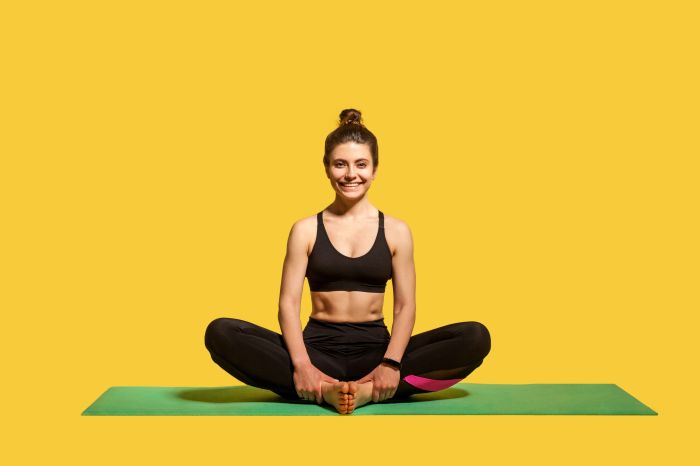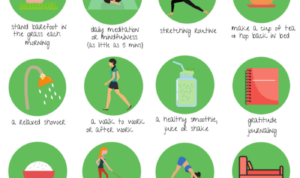Yoga for Beginners takes center stage, inviting you to embark on a journey towards wellness through a blend of physical and mental benefits. Get ready to dive into the world of yoga for a rejuvenating experience like no other!
Benefits of Yoga for Beginners
Yoga offers a myriad of benefits for beginners, encompassing both physical and mental well-being.
Physical Benefits
- Improves flexibility: Yoga poses help stretch and lengthen muscles, enhancing overall flexibility.
- Builds strength: Holding yoga poses requires engaging various muscle groups, leading to increased strength.
- Enhances balance: Practicing yoga poses helps improve balance and stability through body awareness.
Mental Health Advantages
- Reduces stress: The focus on breathing and mindfulness in yoga can help lower stress levels and promote relaxation.
- Boosts mood: Yoga releases endorphins, which are known as “feel-good” hormones, improving mood and overall mental well-being.
- Increases mindfulness: Practicing yoga encourages being present in the moment, fostering mindfulness and mental clarity.
Overall Well-being
- Improves posture: Yoga helps align the spine and strengthen core muscles, leading to better posture.
- Supports weight management: Regular yoga practice can aid in weight loss and weight maintenance by increasing metabolism.
- Enhances sleep quality: Relaxation techniques in yoga can promote better sleep patterns and overall sleep quality.
Essential Yoga Poses for Beginners: Yoga For Beginners
Yoga poses, also known as asanas, are key to a successful yoga practice. Here are some simple yet effective poses suitable for beginners.
Mountain Pose (Tadasana)
Mountain Pose is a foundational standing pose that helps improve posture and balance. Stand tall with feet hip-width apart, arms by your sides, and palms facing forward. Engage your core, lengthen your spine, and relax your shoulders. Breathe deeply and hold for a few breaths.
Child’s Pose (Balasana)
Child’s Pose is a calming pose that stretches the back, hips, and thighs. Start on your hands and knees, then sit back on your heels while reaching your arms forward. Rest your forehead on the mat and relax your entire body. Breathe deeply and hold the pose for a few breaths.
Downward-Facing Dog (Adho Mukha Svanasana), Yoga for Beginners
Downward-Facing Dog is a rejuvenating pose that strengthens the arms, shoulders, and legs. Begin on your hands and knees, then lift your hips up and back, forming an inverted V shape. Press your hands and feet into the mat, lengthen your spine, and relax your head. Hold the pose while breathing deeply.
Warrior I (Virabhadrasana I)
Warrior I is a powerful pose that builds strength and stamina. Step one foot back, keeping it at a 45-degree angle, while bending the front knee directly over the ankle. Raise your arms overhead, palms facing each other, and gaze up. Square your hips and hold the pose while breathing deeply.
Corpse Pose (Savasana)
Corpse Pose is a restorative pose that promotes relaxation and rejuvenation. Lie flat on your back, arms by your sides, palms facing up. Close your eyes, relax your entire body, and focus on your breath. Stay in this pose for a few minutes to end your practice.
Tips for Starting a Yoga Practice
Starting a yoga practice can be a rewarding journey towards improved physical and mental well-being. Here are some tips to help beginners establish a consistent routine, find the right resources, and select appropriate gear and props.
Establishing a Consistent Yoga Routine
- Set a specific time each day for your yoga practice to create a routine.
- Start with shorter sessions and gradually increase the duration as you build strength and flexibility.
- Find a quiet and peaceful space where you can focus on your practice without distractions.
- Listen to your body and take breaks when needed to avoid overexertion.
Finding the Right Resources for Beginners
- Look for beginner-friendly yoga classes or tutorials online or in local studios.
- Consider joining a beginner’s yoga group or community for support and motivation.
- Explore different styles of yoga to find one that resonates with your goals and interests.
- Seek guidance from experienced yoga instructors to ensure proper alignment and technique.
Selecting Appropriate Yoga Gear and Props
- Invest in a good quality yoga mat that provides sufficient cushioning and grip.
- Choose comfortable and breathable yoga clothing that allows for ease of movement.
- Consider using props such as blocks, straps, and bolsters to support your practice and enhance flexibility.
- Stay hydrated during your practice by having a water bottle nearby.
Common Mistakes to Avoid in Beginner Yoga

Starting a yoga practice can be exciting, but it’s important to be mindful of common mistakes that beginners tend to make. By being aware of these errors, you can prevent injuries, strain, and make the most out of your yoga sessions.
Pushing Too Hard
- Avoid pushing your body beyond its limits, especially when starting out.
- Listen to your body and respect its boundaries to prevent injuries.
- Focus on gradual progress and improvement rather than forcing yourself into difficult poses.
Incorrect Alignment
- Ensure proper alignment in each yoga pose to avoid strain on joints and muscles.
- Consult with a yoga instructor to learn the correct alignment for different poses.
- Use props like blocks and straps to support your body and maintain proper alignment.
Lack of Mindfulness
- Practice mindfulness during yoga sessions by focusing on your breath and body sensations.
- Avoid distractions and stay present in the moment to fully experience the benefits of yoga.
- Be aware of your thoughts and emotions, and try to cultivate a sense of inner calm and relaxation.












